The recyclable packaging market is estimated to be valued at USD 31.94 Bn in 2025 and is expected to reach USD 43.78 Bn by 2032, growing at a compound annual growth rate (CAGR) of 4.6% from 2025 to 2032.
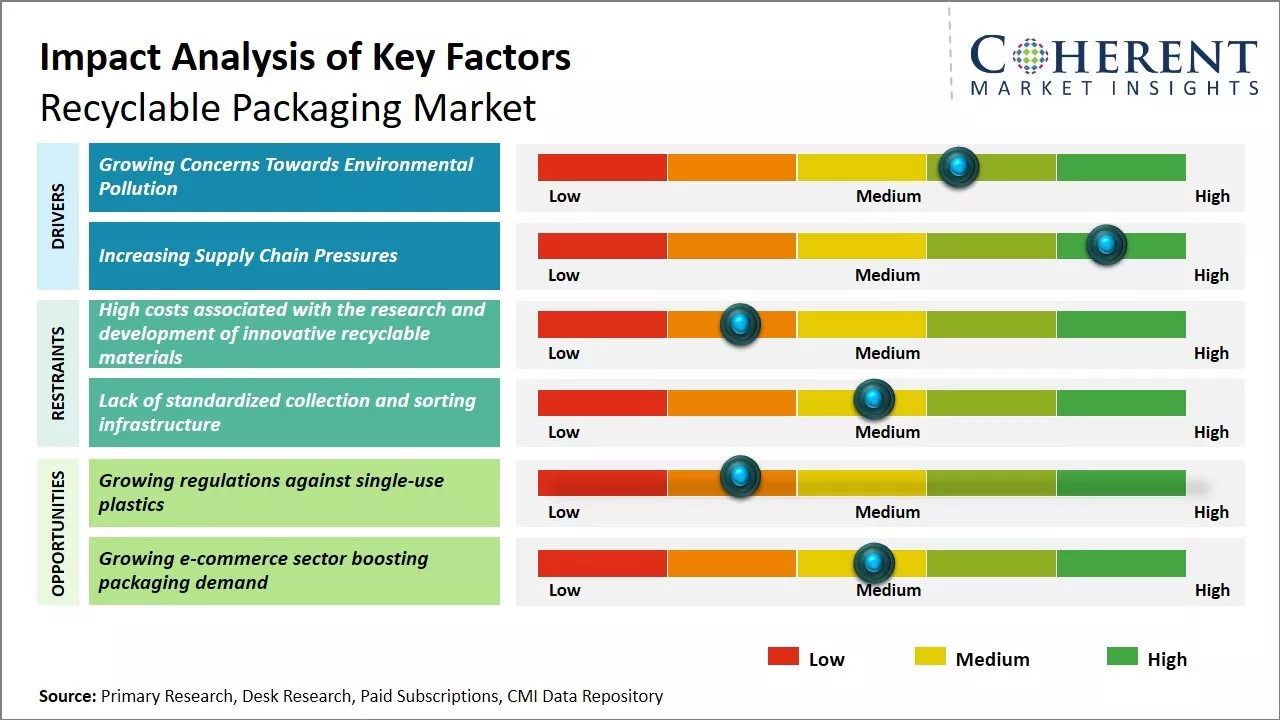
Discover market dynamics shaping the industry: Request sample copy
This above average growth can be attributed to the increasing demand from industries like food and beverage, healthcare, and personal care sectors driving the need for sustainable packaging solutions. The market is witnessing positive trends that are expected to propel the demand for recyclable packaging. Stringent government regulations regarding the use of eco-friendly materials along with a rise in sustainability initiatives by leading brands are increasing the adoption of recyclable packaging materials like paper, glass, plastic, and metal. Additionally, growing environmental concerns among consumers have pushed companies to opt for recyclable options.
Growing Concerns towards Environmental Pollution
With rising concerns around the world regarding pollution in all forms, there is an increasing demand from both businesses and customers for more environmentally sustainable packaging solutions. Customers today are more conscious about the impact of their purchasing decisions on the environment and looking to support brands that are making efforts towards reducing waste. Recyclable and reusable packaging allows companies to promote their environmental and social responsibilities. It also resonates well with the positive sentiment among people for minimizing the use of plastic and other non-biodegradable materials. Recycling has become a mainstream activity now with most municipalities offering regular collections of items like paper, glass, metals, and certain plastics. With proper sorting and processing, these materials can be converted into new products, thus preventing them from ending up in landfills. This, in turn, is helping to reduce greenhouse gas emissions and conserve natural resources. Sustainable packaging is proving to be an important parameter for consumers while choosing between brands. Merely claiming to be sustainable is not enough now, companies need to demonstrate tangible actions and quantifiable metrics around using recycled content and supporting circular economy. The growing importance of environmental sustainability in business decisions is a key driver propelling the demand for recyclable packaging worldwide.
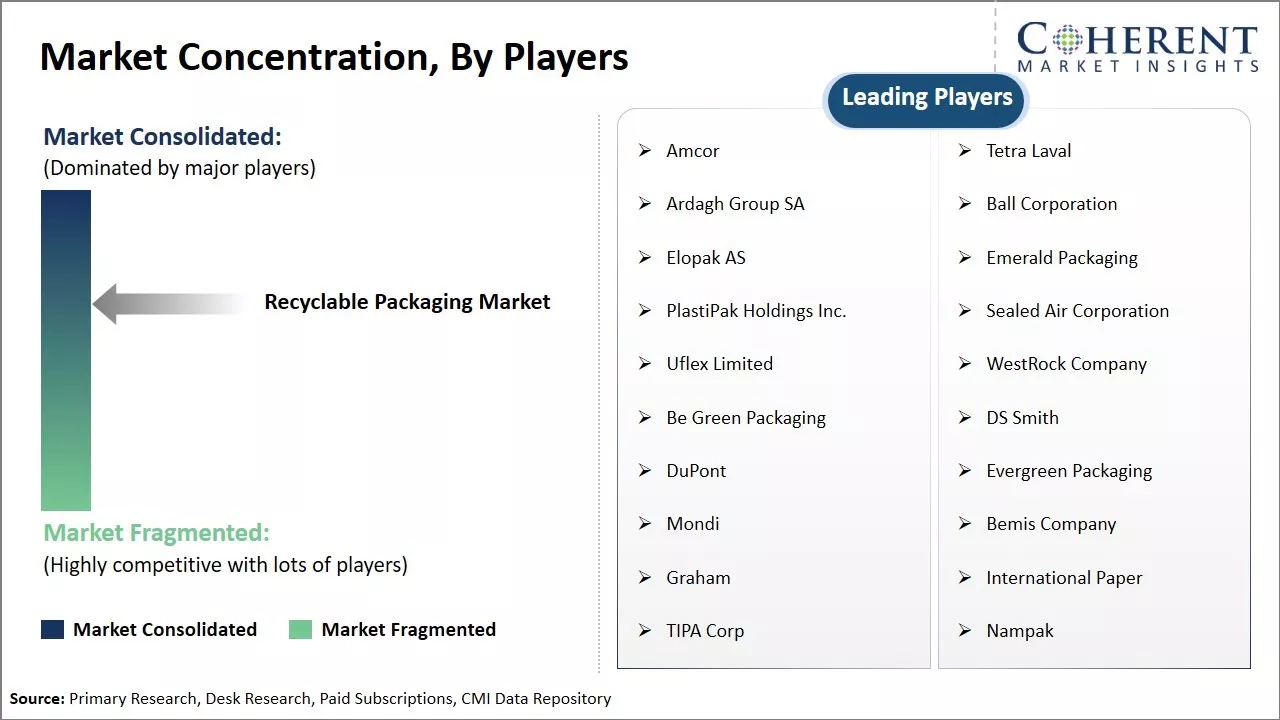
Get actionable strategies to beat competition: Request sample copy
Increasing Supply Chain PressuresApart from external pressures, brand owners and retailers themselves are facing increasing challenges within their supply chains that can potentially be addressed through recyclable packaging. Issues like rising commodity and transportation costs, complexities of global sourcing and logistics, capacity constraints, and disruptions are forcing companies to optimize operations. Recyclable and reusable packaging allows the removal of unnecessary and wasteful materials from the supply chain without compromising on protection and performance. It results in reduced raw material consumption, lower packaging to product ratios, and improved transport utilization. Flexible and lightweight designs offer further savings potential. An efficient closed-loop supply chain where packaging is collected after use, sorted and processed for making new packaging improves material circulation. This extends the functional lifespan of packaging materials and locks away the economic value within the system. By integrating sustainability goals into core business strategy and redesigning packaging accordingly, companies can enhance supply chain resilience and prepare for future disruptions. The commercial drivers of reducing operational costs, mitigating supply risks, and gaining competitive differentiation are thus encouraging greater uptake of recyclable solutions across industries.
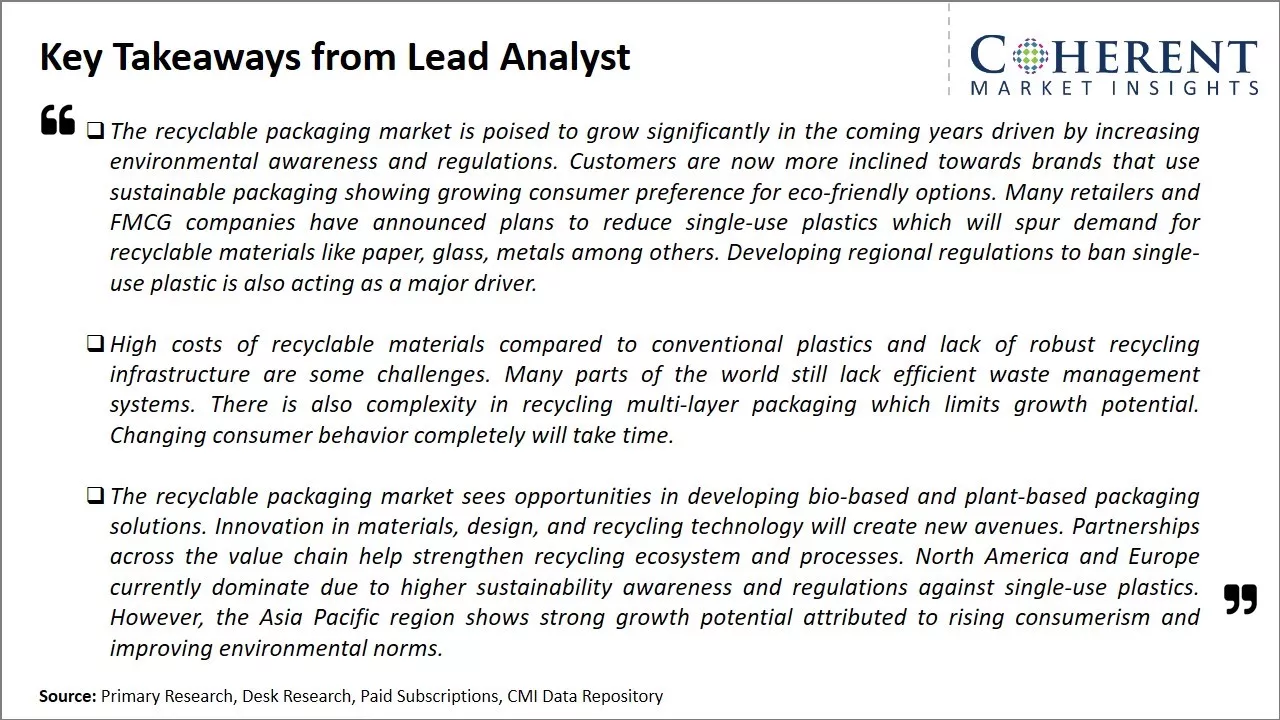
To learn more about this report, Request sample copy
Market Challenges: High costs associated with the research and development of innovative recyclable materialsThe recyclable packaging market faces several challenges. High costs remain associated with the research and development of innovative recyclable materials. Additionally, producing recyclable packaging at scale brings expenses that traditional plastics do not incur. Educating consumers about proper recycling practices and distinguishing various recyclable packaging presents a further hurdle. Changing consumer preferences to favor sustainable options also poses a challenge, as many remain unfamiliar with recyclable alternatives.
Market Opportunities: Growing regulations against single-use plastics
Growing regulations against single-use plastics are driving packaging manufacturers to pursue recyclable materials. Consumer demand for eco-friendly products continues rising, opening a market for sustainable options. Recyclable packaging allows brands to appeal to this demand and boost their green credentials. Furthermore, advancements in material sciences make recyclable paper, glass and metal more functional competitors to plastics.
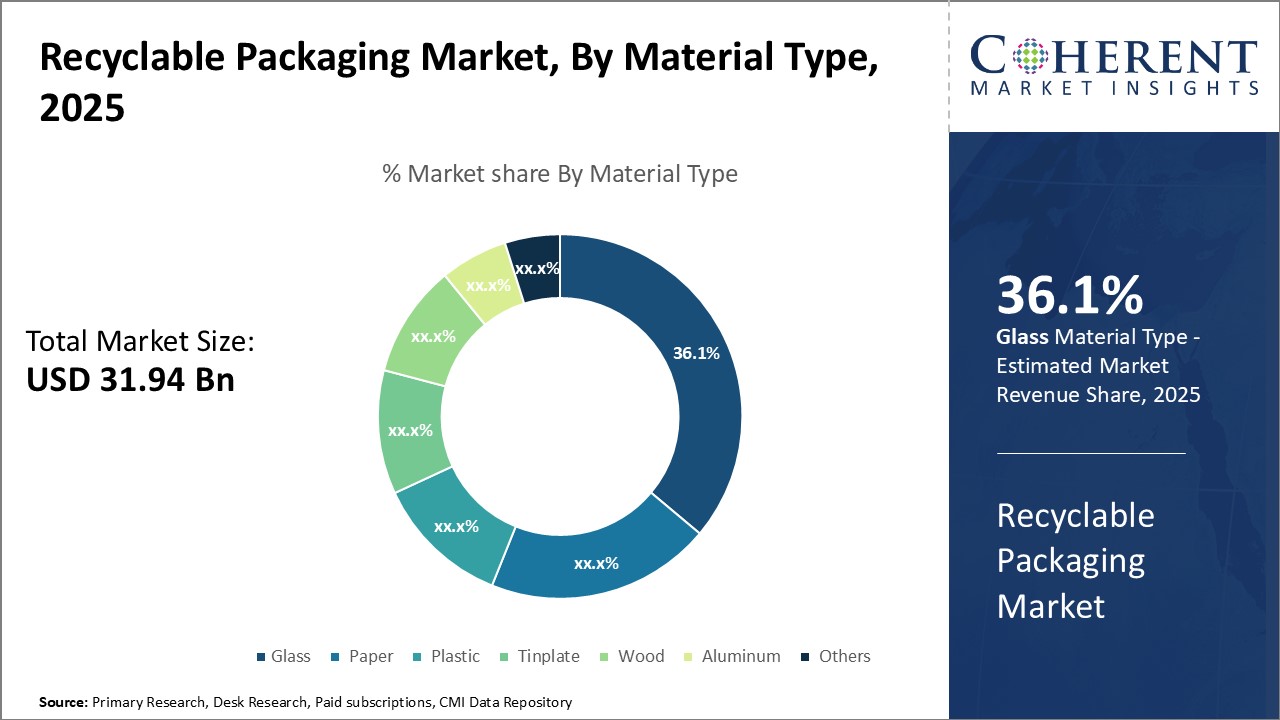
Discover high revenue pocket segments and roadmap to it: Request sample copy
Insights, By Material Type: Sustainable nature and versatile applications drive paper packaging growthIn terms of material type, paper contributed 36.1% share of the market owing to its inherent sustainable nature and ability to be widely used across various packaging applications. Paper being a naturally renewable material sourced from sustainably managed forestry helps paper packaging gain traction among brand owners targeting eco-conscious customers. Furthermore, paper excels in printability and provides brands opportunities to leverage visual appeal for better promotions and branding on store shelves. The porosity and breathability of paper also makes it suitable for food and agricultural applications where permeability to gases is important. Additional recyclability of paper after use further boosts its credentials as an environment-friendly packaging material. The versatility of paper to be converted into various formats like cartons, carton board, wraps etc. also supports its high usage across industries like food, consumer goods, electronics and more.
Insights, By Packaging Type: Ease of shipping drives corrugated boxes growth
In terms of packaging type, corrugated boxes contributed 42.8% share of the market owing to its rigidity, resilience, and cost-effectiveness in protecting products during shipping and transportation. Corrugated boxes provide ample strength and cushioning to packaged items without adding much weight. The interlocking flute profile of corrugated cardboard absorbs impacts and prevents damages to products inside during logistical movements involving handling, stacking and transportation over long distances. Additionally, corrugated boxes are highly customizable with print and die-cut capabilities to manufacture boxes in various shapes and sizes according to product dimensions. This fits packages perfectly and optimizes space during shipping. Their recyclability after usage also makes corrugated boxes more sustainable versus alternative rigid packaging options. Growing e-commerce and demand for safe product delivery continues to spur usage of corrugated boxes across industries.
Insights, by End User: Mass consumption powers the food and beverage packaging demand
In terms of end user, food & beverage contributed 40.4% share of the market owing to immense volumes of food products being packaged and sold every day globally. Right from basic commodities to ready-to-eat snacks and beverages, effective and compliant packaging plays a key role in the marketing, storage, distribution, and consumption of a wide variety of food and drink items. Food packaging helps meet regulatory safety and quality needs while also improving brand visibility and driving impulse purchases. Features like re-closure, microwaveability and on-the-go convenience further aid packaging sales in the food and beverage industry. Continued urbanization and evolving lifestyles demanding greater portability and meal replacement options will remain key drivers for sustainable and innovative packaging design catering to the massive food and drinks industry.
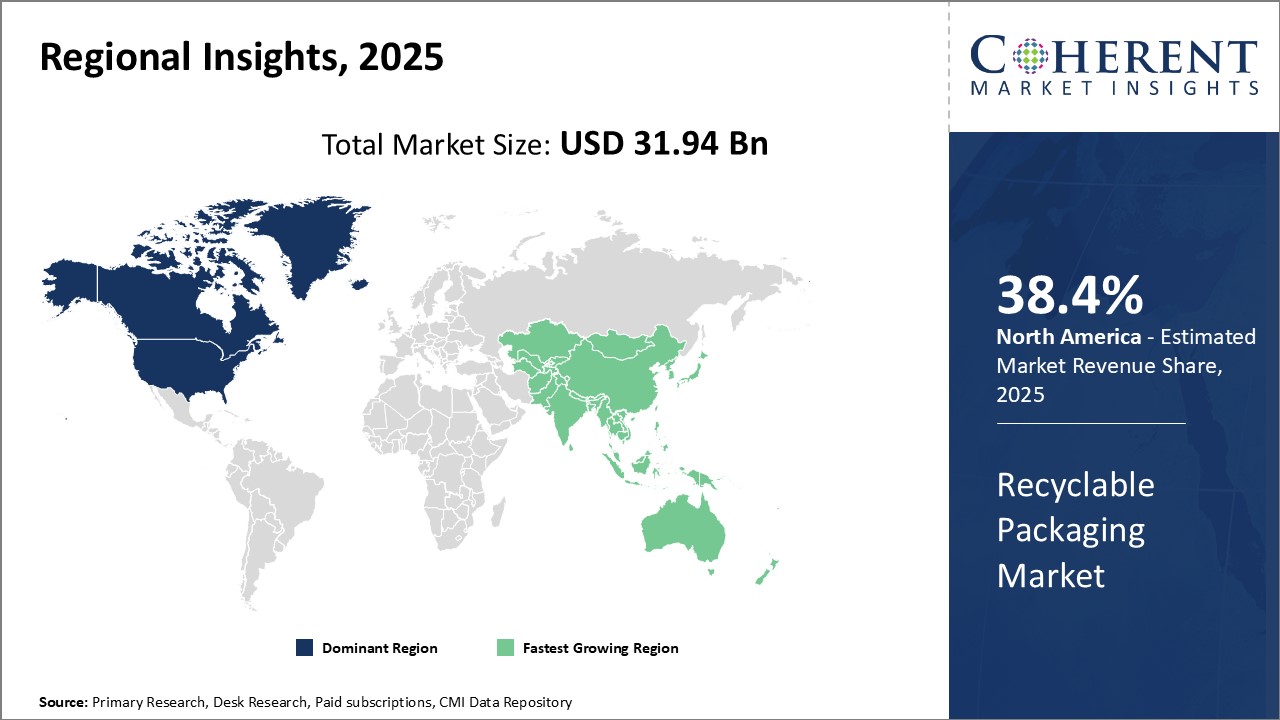
Need a Different Region or Segment? Customize now
North America dominates the global recyclable packaging market with 38.4% of the market share, owing to strong government support and regulations towards environment protection and waste management in the region. Countries like the U.S. and Canada have implemented strict packaging waste management laws that mandate higher usage of recyclable materials in packaging. This has compelled leading FMCG and consumer durable companies in North America to increasingly rely on recyclable packaging solutions. The region is also a pioneer in recycling technology with presence of global leaders. Moreover, the strong presence of recycling infrastructure and collection systems have streamlined the recycling process in North America.
The Asia Pacific region is fast emerging as another major market for recyclable packaging. Countries like China, India, and other Association of Southeast Asian Nations (ASEAN) nations are witnessing rapid industrialization and economic growth. This has boosted the packaging industry manifold in the region. However, lack of proper waste management was a major issue until recently. Now, governments in Asia Pacific are promoting sustainable development through initiatives targeting waste reduction. Also, growing health and environment concerns among urban middle-class population have increased demand for green packaging. ASEAN countries especially are strategically positioned to tap the export potential of recyclable packaging to developed markets due to availability of raw materials and competitive manufacturing costs. Domestic packaging producers in Asia Pacific have also strengthened their portfolio of recyclable offerings to comply with evolving sustainability priorities of global brands. The favorable regulatory environment and diverse market opportunities make Asia Pacific the fastest growing regional market.
Recyclable Packaging Market Report Coverage
| Report Coverage | Details | ||
|---|---|---|---|
| Base Year: | 2024 | Market Size in 2025: | USD 31.94 Bn |
| Historical Data for: | 2020 To 2024 | Forecast Period: | 2025 To 2032 |
| Forecast Period 2025 to 2032 CAGR: | 4.6% | 2032 Value Projection: | USD 43.78 Bn |
| Geographies covered: |
|
||
| Segments covered: |
|
||
| Companies covered: |
Amcor, Tetra Laval, Ardagh Group SA, Ball Corporation, Elopak AS, Emerald Packaging, PlastiPak Holdings Inc., Sealed Air Corporation, Uflex Limited, WestRock Company, Be Green Packaging, DS Smith, DuPont, Evergreen Packaging, Mondi, Bemis Company, Graham, International Paper, TIPA Corp, and Nampak |
||
| Growth Drivers: |
|
||
| Restraints & Challenges: |
|
||
Uncover macros and micros vetted on 75+ parameters: Get instant access to report
*Definition: The recyclable packaging market consists of companies that manufacture and sell packaging materials made from reusable and recyclable resources. This includes packaging for food, beverages, pharmaceuticals, household goods, and other consumer products that are produced using paper, glass, plastic, metal, or other materials that can be collected after use and reprocessed into new products or packaging.
Share
Share
About Author
Shivam Bhutani has 6 years of experience in market research and strategy consulting. He is a Market Research Consultant with strong analytical background. He is currently an MBA candidate specializing in Business Analytics from BITS Pilani.
He is adept at navigating diverse roles from sales and marketing to research and strategy consulting. He excels in market estimation, competitive intelligence, pricing strategy, and primary research. He is skilled at analysing large datasets to provide precise insights, helping clients in achieving strategic transformation across various industries. He is skilled in leveraging data visualization techniques to drive innovation and enhance business processes.
Missing comfort of reading report in your local language? Find your preferred language :
Transform your Strategy with Exclusive Trending Reports :
Frequently Asked Questions
Joining thousands of companies around the world committed to making the Excellent Business Solutions.
View All Our Clients
US Reciprocal Tax Impact Analysis On Recyclable Packaging Market
Stay updated on tariff changes with expert insights and timely information